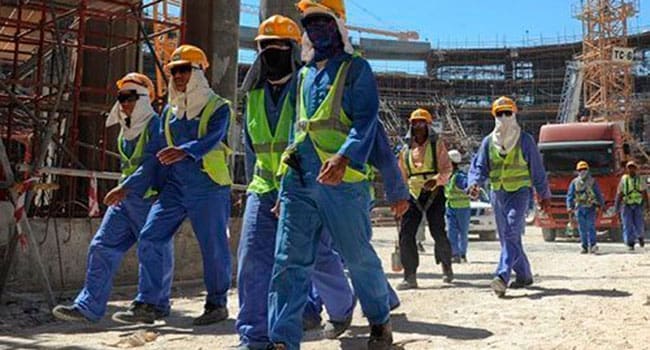 Of all the egregious forms of modern slavery, none is more despicable or far-reaching than the export of labour by North Korea.
Of all the egregious forms of modern slavery, none is more despicable or far-reaching than the export of labour by North Korea.
It’s estimated that North Korean slave labour is used in more than 45 countries, including in the European Union, and entails the exploitation of 100,000 to 200,000 individuals.
The government of North Korea and various affiliated organizations earn an estimated US$2 billion to $3 billion yearly from the exploitation of its citizens as slave labour. As economic sanctions have bitten deeper into North Korea’s economy, the government has responded by steadily increasing the number of labourers it exports.
Since coming to power in 2012, Kim Jong-un has overseen a significant rise in the export of North Korean labour. It’s estimated that labourers overseas have increased from around 65,000 in 2000 to 100,000 to 200,000 now. These workers only receive 10 to 20 per cent of their designated wages. All wages are paid directly to the North Korean companies overseeing the work and they in turn pay the workers.
About 14 organizations in the Workers’ Party of Korea (WPK), government and military export of North Korean workers. Their activities are centred around five North Korean banks used to repatriate and hold foreign currency accounts. Access to hard currencies is highly coveted and ensures participants access to western goods and a very comfortable lifestyle. The Kim family has used such access to reward its supporters.
In addition to their labour exports, these organizations conduct trade, and operate hotels, Korean-themed restaurants and gift stores selling traditional crafts, principally in China and Russia. All are staffed by North Koreans. They also operate tourism facilities in North Korea.
An organization called Office 39, part of the WPK, administers 17 foreign branches and 100 trading companies. It’s also responsible for North Korea’s exports of gold bullion, about a tonne a year, and oversees the country’s foreign currency counterfeiting. It’s also believed to engage in some drug trafficking and arms sales.
Western intelligence agencies estimate that Office 39 generates US$500 million to $1 billion a year in revenue. Funds are earmarked for the country’s nuclear program and, it’s believed, the personal use of Kim Jong-un. According to a recent U.S.-South Korea joint government investigation, Office 39 controls around US$5 billion in assets worldwide.
The bulk of the workers are in China, Russia and the Persian Gulf emirates. There are approximately 50,000 workers in China, some employed in firms owned by North Korean agencies. Labour shortages in China, especially in the northeast, are often filled by North Koreans.
There are roughly 25,000 North Korean workers in Russia, mostly in the timber industry in eastern Siberia and the construction industry in western Russia. There are about 20,000 workers in the Middle East, mostly in construction and medical-related fields. There are 15,000 workers in Southeast Asia, around 10,000 in Africa. and 5,000 in each of Europe and Mongolia.
Work conditions are typically spartan. In many places, workers are housed six to eight to a room and work 60-to-80-hour weeks. North Koreans employed in the construction of the Zenit Arena in Saint Petersburg were reportedly housed eight to a 20-by-eight-foot shipping container.
Average salaries vary by country. They’re higher in the Gulf, lower in China and Russia. On average, they’re paid US$300 to $400 a month. Workers receive 10 to 20 per cent of their official wages. The balance is retained by the North Korean agency that organized the labour export and its intermediaries.
Is this slavery?
As brutal as it appears, for some, sadly, it’s a better quality of life than what’s found in North Korea. Most workers acknowledge they’re better fed and have better medical care than their countrymen. In fact, North Koreans often bribe government officials to become overseas labourers. The going rate is US$200 to $700.
Once abroad, workers can work on the side for their own benefit or even operate a business. Many engage in trading activities, the supplies for which, like the sale of black market cigarettes and other contraband, are supplied by the local North Korean embassy.
Putting aside the obvious question of whether Pyongyang’s export of labour constitutes a form of slavery, there are three issues to consider.
First, the export of labour allows North Korea to earn billions of dollars in hard currency. These earnings play an important role in funding the country’s nuclear weapons development program, and are critical in keeping the Kim family and its cronies in power.
Labour exports also allow the government to circumvent the effect of economic sanctions on its international trade. As sanctions have bitten deeper, Kim Jong-un has responded by simply increasing the number of workers North Korea exports.
In recent years, North Korea has run deficits of US$350 million to $1 billion in foreign trade. Without the earnings from the export of labour, it’s likely North Korea would undergo the same cash squeeze it experienced in the 1990s and possibly collapse. It’s essential that labour exports be included in the sanctions levied against North Korea. Ditto for tourism into North Korea.
Moreover, the five North Korean banks at the centre of the labour exports need to be completely cut off from the international banking system. And any financial institution that acts as an intermediary for them needs to be subject to sanctions itself. Without the ability to move funds, the export of North Korean labour would yield little profit to Kim Jong-un and his cronies.
Secondly, coercion and exploitation of forced labour has become an accepted part of North Korean life. Many schools, for example, impose fees on students. Students as young as five are forced to work in lieu of making cash payments or as a team-building exercise.
Finally, North Korea’s exploitation of its workers could not occur without the acquiescence of the West. There are numerous instances where the use of North Korean labour has been open and well documented. The use of North Koreans in Polish shipyards and the Czech Republic is well known. The new stadiums being built to host the World Cups in Saint Petersburg (2018) and in Qatar (2022) are being constructed with the use of North Korean labour.
Hundreds of thousands of World Cup fans will buy tickets to sit in stadiums built with slave labour. International broadcasters will each pay hundreds of millions of dollars to televise games from those same stadiums. Where is the outrage from the West? Why hasn’t any western government demanded that FIFA either cancel or reschedule the World Cups to venues untainted by the use of slave labour?
Not only is the countenance of North Korea’s labour exports a tacit acceptance of the continuation of slavery in the 21st century, but it directly leads to a major source of global nuclear proliferation and regional instability.
It’s time to put a stop to North Korea’s brutal exploitation of its citizens.
Joseph Micallef is an historian, best-selling author and, at times, sardonic commentator on world politics.
Joseph is a Troy Media Thought Leader. Why aren’t you?
The views, opinions and positions expressed by columnists and contributors are the author’s alone. They do not inherently or expressly reflect the views, opinions and/or positions of our publication.

